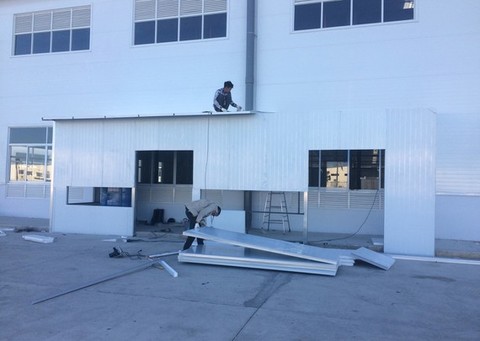
A building being constructed with environment-friendly materials in HCM City. — Photo: Sai Gon Giai Phong
The number of construction works built using environment-friendly materials is steadily increasing in HCM City thanks to the convenience and economy they offer and thus a competitive advantage to builders.
Dong Chau Production, Trading, and Service Company in Binh Thanh District was barely hit by the COVID-19 pandemic unlike most construction enterprises.
Le Tien Linh, its director, explained that many factories urgently needed to build accommodation for their workers during the pandemic.
"We received many construction contracts from them because we use prefabricated building materials,” he said.
The materials it uses meet needs like quick construction and reasonable prices, he added.
A spokesperson for Tecco Real Estate Services Company’s West Saigon office said his firm always advises clients to choose new and environment-friendly bricks, aluminium frames, glass, and decorative wall tiles.
“This has been creating a competitive advantage for the company in the market.”
Nguyen Thanh Nhan of the HCM City University of Technology said new building materials and assembly building technologies have become popular thanks to the huge advantages they offer compared to traditional materials.
By using expanded polystyrene panels, enterprises can cut costs by at least 30 per cent compared to traditional houses.
With prefabricated houses, the workload is reduced significantly, purlin costs are saved, construction is quick, and insulation costs and power consumption are lower.
“Moreover, these materials are easy to construct with precise dimensions reduce material losses during construction,” Nhan said.
Building prefabricated houses only takes half the time needed for traditional ones, and does not depend much on weather and climate factors because the modules are processed and manufactured in the factory, he said.
“Designs using new building materials are more and more diverse and aesthetically pleasing, and so are increasingly popular.”
Hoang Van Tin of the city Architects Association said by using prefabricated lightweight building materials such as EPS panels foundations could be built on any terrain, even water.
“Not to mention that future expansion is quite simple and the cost is not as high as for traditional houses.”
Prefabricated houses can be easily dismantled and moved to another place, he said.
There are no official statistics on the use of new building materials, but market data shows they are gradually gaining in popularity.
Many members of the association said they are being increasingly commissioned to design works using new building materials.
Promoting production and use of green building materials
The use of traditional building materials affects the environment and has consequences like land loss and increase in greenhouse and other harmful gas emissions.
To make a billion burnt clay bricks, 1.5 million cubic metres of clay must be extracted from a depth of up to two metres, equivalent to 75 hectares of agricultural land.
More than 10 years ago the Government issued a decision on developing environment-friendly unburnt building materials for environmental protection.
There are now more than 1,600 factories producing concrete bricks (aggregate cement bricks), autoclaved/non-autoclaved aerated concrete bricks, foam concrete blocks, hollow-core concrete panel (acotec), and autoclaved aerated concrete wall panels.
The total design capacity of these facilities is around 10.2 billion standard blocks per year, or almost 30 per cent of the total building materials production capacity.
The country annually saves 7.5 million cubic meters of clay, equivalent to 375ha of land exploited to a depth of two metres, reduces coal consumption by 750,000 tonnes, and cuts carbon dioxide emissions by 2.85 million tonnes.
But the figure is still modest compared to the total construction demand in the country.
The biggest hurdle to using ‘green’ building materials is the entrenched habit of using iron and reinforced concrete in house construction, according to experts.
Many enterprises producing building materials have limitations in terms of technology, funds and experience that stymie their efforts to make new environment-friendly products, they said.
Clear preferential policies are needed to encourage the production of environment-friendly building materials, they added. — VNS